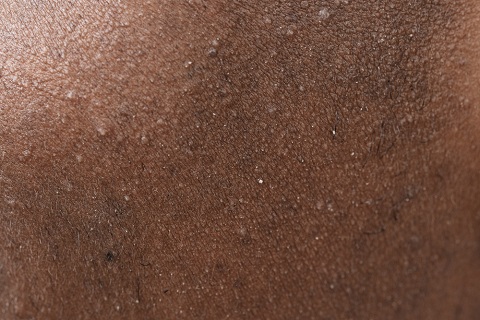Pellagra is a nutritional deficiency disease characterized by a deficiency of niacin (vitamin B3) and/or its precursor, tryptophan. Historically, it was prevalent in regions where corn was a dietary staple, as corn lacks sufficient niacin unless treated with lime. This condition gained attention in the early 20th century when it became endemic in parts of the United States, particularly in the southern states.
Dietary sources of preformed Niacin are meat, fish, liver, kidney, wholemeal wheat, bran, yeast, coffee, legumes, peanut and vaious dairy products.
It is due to deficiency of Nicotinic acid characterised by the tried dermatitis, diarrhoea and dementia in advanced cases. But this triad is not always present. Daily requirement of Nicotinic acid in adults is 15-20mg.
Causes of Pellagra
Pellagra primarily results from inadequate intake or absorption of niacin. It can stem from:
- Vitamin deficiency: Inadequate dietary intake of niacin or tryptophan.
- Dietary factors: Consumption of a diet high in corn-based products without sufficient niacin supplementation.
- Genetic predisposition: Some individuals may have genetic variations affecting niacin metabolism, increasing their susceptibility to pellagra.
- Digestive Disorders: Conditions such as Crohn’s disease or celiac disease can impair nutrient absorption, including niacin.
Symptoms of Pellagra
Pellagra manifests with a triad of symptoms affecting the skin, gastrointestinal tract, and nervous system. In early stages non specific symptoms like anorexia, glossitits, weight loss, develop. These include:
Dermatological symptoms:
Characterized by photosensitive dermatitis, commonly affecting sun-exposed areas, resulting in erythema, scaling, and eventually, thickening and darkening of the skin. Erythema symmetrically appears on sun exoposed parts of body especillay on the back of hands, wrist, forearms, face, and neck. There is redness, swelling and itching. There may be cracking, exudation and ulceration in acute cases. In chronic stage there is roughening of skin which may be dry with scaling.
Gastrointestinal symptoms:
Tongue is characcteristically raw, beef-red, painful and swollen due to hypertrophy of the papillae of the tongue. Gradually there is atrophy of the papillae. Including diarrhea, abdominal pain, and inflammation of the mouth(Stomatitis). Anorexia, nausea and burning sensation in epigastrium may develop. Large amount of watery stool is passed.
Neurological symptoms:
Such as confusion, depression, insomnia, fatigue, weakness, anxiety, mental dullness, apathy and irritability and eventually dementia if left untreated.
Sometimes acute cases show delirium and chronic cases will have amnesia, confusion, hallucianation and psychosis.
Mucosal Changes
Pellagra can also affect mucous membranes, leading to soreness and inflammation in the mouth and digestive tract.
Diagnosis
Niacin metabolites specially N-methyl-nicotinamide in the urine is low.
Diagnosing pellagra involves a combination of clinical evaluation and laboratory tests. Physicians may consider a patient’s dietary history, clinical symptoms, and perform blood tests to assess niacin levels and confirm the deficiency.
Serum and RBC level of NAD and NADP is also low. But these tests are nonspecific.
How do you prevent pellagra?
Preventing pellagra involves ensuring adequate intake of niacin through:
- Balanced diet: Incorporating a variety of niacin-rich foods into daily meals.
- Vitamin supplements: Especially for individuals at risk of deficiency due to dietary restrictions or medical conditions.
- Diversify Food Choices: Avoid relying heavily on single food sources, especially those that are low in niacin. Incorporate a variety of foods into your meals to ensure you’re getting a sufficient amount of this essential vitamin.
- Alcohol Moderation: Excessive alcohol consumption can interfere with niacin absorption and contribute to the development of pellagra. Limiting alcohol intake or seeking support for alcohol addiction can help prevent niacin deficiency.
Epidemiology
While pellagra is now rare in developed countries, it still persists in certain regions, particularly where poverty and malnutrition are prevalent. High-risk populations include those with limited access to diverse foods and alcoholics, whose alcohol consumption interferes with niacin absorption.
Complications
Untreated pellagra can lead to severe complications, including:
- Psychiatric complications: Such as psychosis, hallucinations, and suicidal tendencies.
- Long-term effects: Chronic neurological damage and impaired cognitive function may persist even after niacin supplementation.
FAQs about Pellagra Disease
No, pellagra is not contagious. It is a nutritional deficiency disease caused by inadequate intake or absorption of niacin.
Yes, pellagra can be effectively treated and cured with appropriate niacin supplementation and dietary changes.
Individuals with poor dietary habits, alcoholics, and those living in poverty with limited access to diverse foods are at higher risk of developing pellagra.
Foods such as meat, fish, poultry, nuts, whole grains, and legumes are good sources of niacin.
Chronic neurological damage and cognitive impairment may persist as long-term effects of untreated pellagra, highlighting the importance of early diagnosis and treatment.
Conclusion
Pellagra, once a widespread nutritional deficiency disease, is now rare but still poses challenges in certain populations. Understanding its causes, symptoms, and treatment options is crucial for effective management and prevention.





